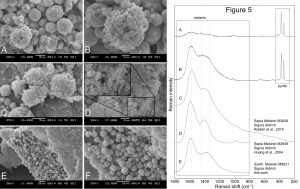 The oldest and until now the only fossil cuttlefish ink sac, possessing microbodies, has been recorded in the Middle Miocene (~13.5-Ma) deposits of the Vienna Basin. The geochemistry of these microbodies has been compared with the ink of the extant genus Sepia. The Raman spectra of melanin from the fossil cuttlefish ink, the S.officinalis melanin, and the synthetic melanin standards, showed identical curves. Therefore, the preservation of delicate cell organelles such as melanosomes has been proven in the fossil material. This investigation also indicates that the melanin (eumelanin) can be resistant to degradation in deep (geological) time.
The oldest and until now the only fossil cuttlefish ink sac, possessing microbodies, has been recorded in the Middle Miocene (~13.5-Ma) deposits of the Vienna Basin. The geochemistry of these microbodies has been compared with the ink of the extant genus Sepia. The Raman spectra of melanin from the fossil cuttlefish ink, the S.officinalis melanin, and the synthetic melanin standards, showed identical curves. Therefore, the preservation of delicate cell organelles such as melanosomes has been proven in the fossil material. This investigation also indicates that the melanin (eumelanin) can be resistant to degradation in deep (geological) time.
Košťák, M., Schlögl, J., Culka, A., Tomašových, A., Mazuch, M., Hudáčková, N. (2018): The unique preservation of Sepia soft tissues in the Miocene deposits (Serravalian, Vienna Basin): Implications for the origin of microbodies in the fossil record. Palaeogeography, Palaeoclimatlogy, Palaeoecology 493, 111-118. (DOI)








